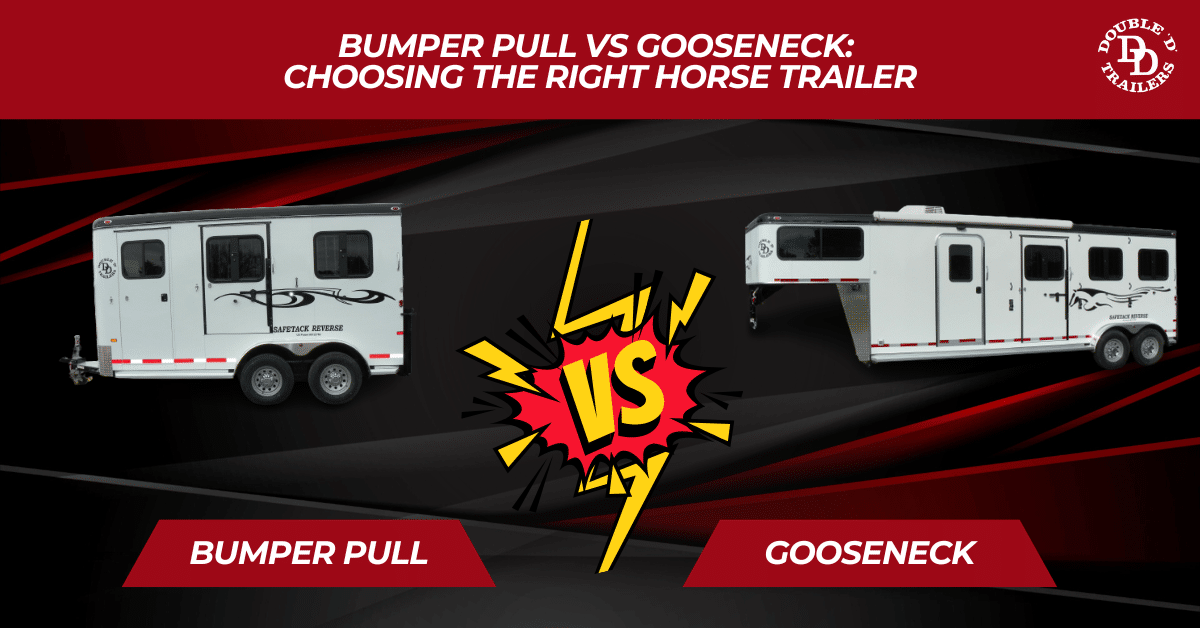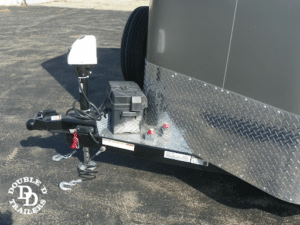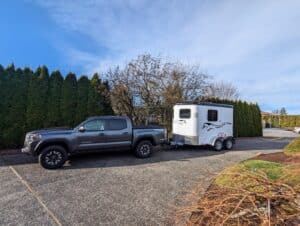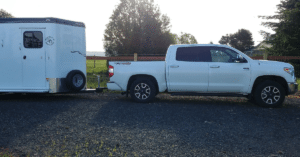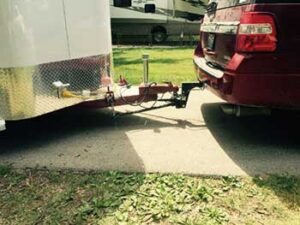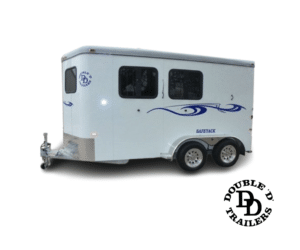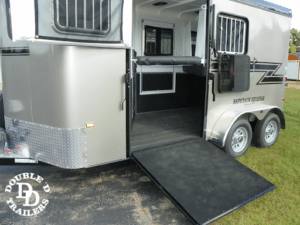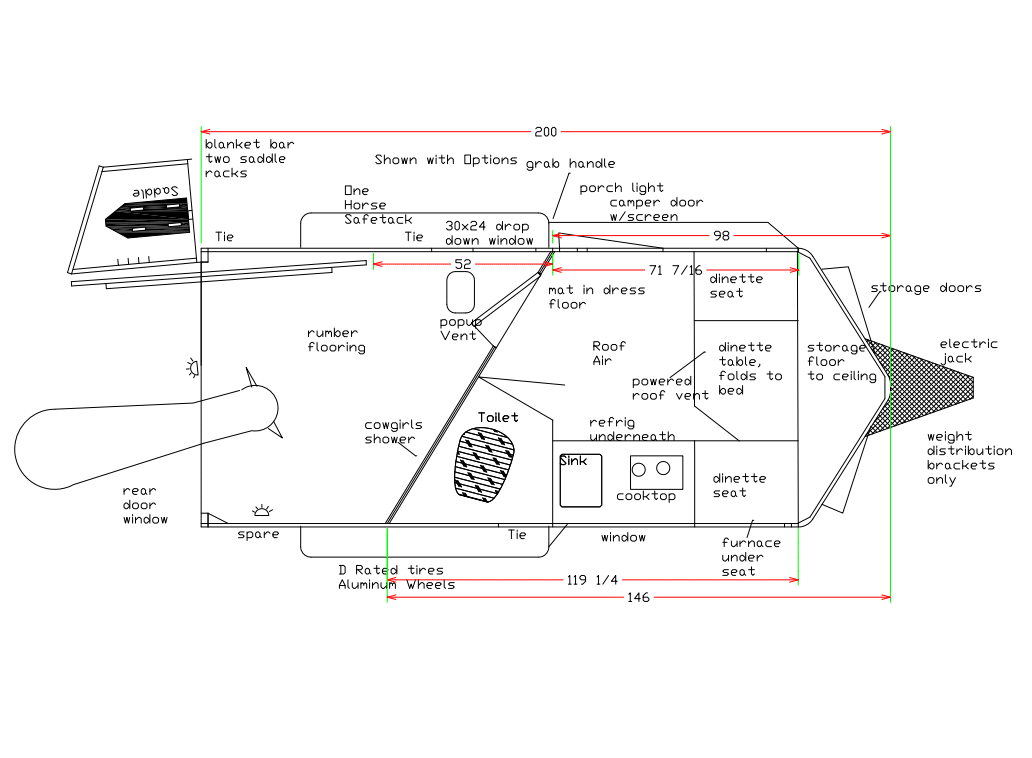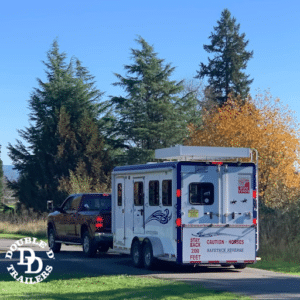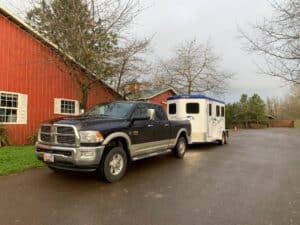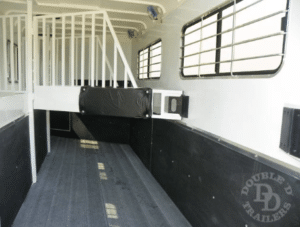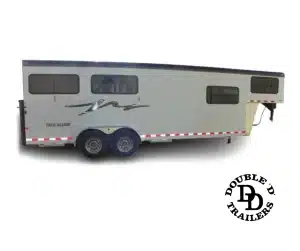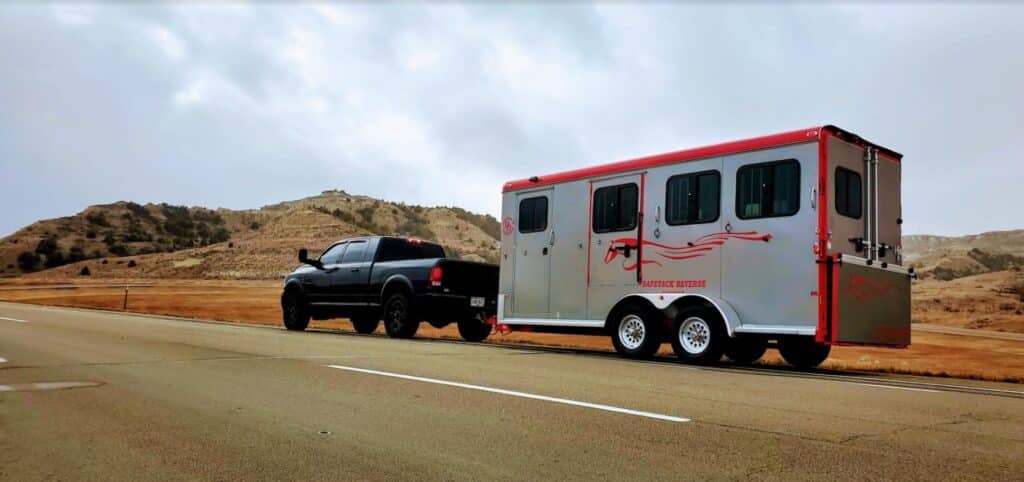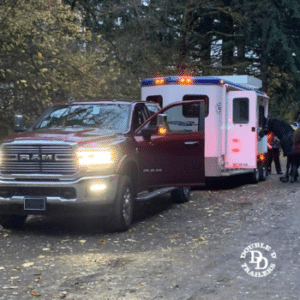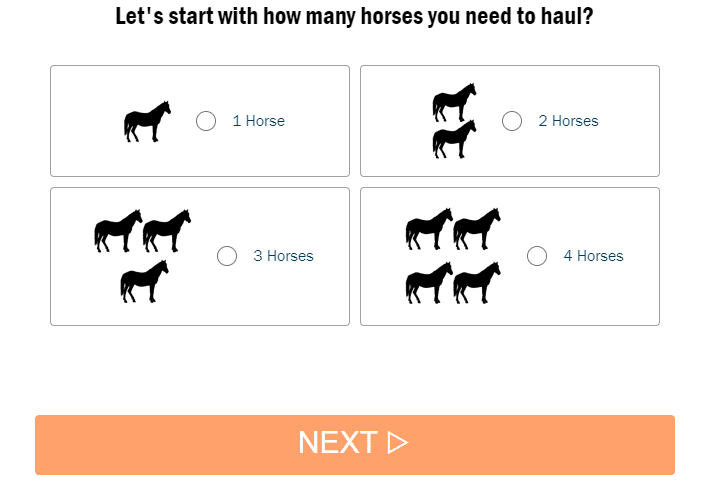Bumper Pull vs Gooseneck: Choosing the Right Horse Trailer
Did you know that the first recorded attempt to transport a horse using a trailer dates back to the 18th century? Things have changed a lot since 1771, though. Today, we have two popular types of horse trailers to choose from: bumper pulls and goosenecks.
If you’ve always wondered which design is better, this guide is for you. We’ll highlight their pros and cons and suggest the key differences to note and considerations to make before going for either type.
10 Key Factors in Comparing Bumper Pull and Gooseneck Horse Trailers
A head-on comparison between bumper pull and gooseneck horse trailers is best done by following a string of factors, such as hitch placement, tow vehicle requirements, maneuverability and ease of towing, weight, costs, horse capacity, sleeping quarters and overall comfort, safety, licenses and regulations, and durability.
1. Hitch Placement
The primary (and most obvious) difference between a bumper pull trailer and a gooseneck model is the tow vehicle’s hitch placement. The former requires a frame-mounted hitch, most often located below or at the tow vehicle’s bumper, hence the name of this trailer design.
One of the limitations related to goosenecks is the fact they can only be pulled by pickup trucks. In this case, the hitch receiver is always placed in the truck’s bed. It’s secured to the truck’s frame for stability and strength. When there’s no trailer attached, the hitch ball can be removed.
2. Tow Vehicle Requirements
What kind of vehicle is needed to tow gooseneck and bumper pull horse trailers? The short answer is “it depends”. As mentioned above, a gooseneck trailer requires a pickup truck to be towed. On the other hand, bumper pull trailers can be attached to SUVs, RVs, pickup trucks, and sometimes even smaller vehicles, depending on the trailer’s dimensions, GVWR (Gross Vehicle Weight Rating), and vertical tongue weight, among other factors. Therefore, a bumper pull would be the better choice if you want to use your daily-driven SUV (as long as it supports the trailer’s weight) to tow it.
Keep in mind that a larger 3H or 4H gooseneck trailer almost always demands a heavy-duty pickup truck. Checking the tow vehicle’s vertical tongue weight capacity alongside its pulling power and GCWR (Gross Combined Weight Rating) compatibility is the foundation of safe towing.
3. Maneuverability and Ease of Driving
Towing a bumper pull rig is a slightly different experience compared to pulling a gooseneck, especially when it comes to performing tricky maneuvers. On the road, the former type follows the tow vehicle’s tracks, which is why bumper pulls are also called tag-along trailers. As a result, a bumper pull trailer navigates narrow, twisty roads with greater ease.
When towing a gooseneck, the smaller turning radius typical of this trailer type requires more attention and precision until certain habits are created. While goosenecks might be harder to get used to at first, they don’t cause additional stress when compared to towing a bumper pull.
But how does maneuverability differ between gooseneck and bumper pull trailers? It all comes down to experience and preferences. Since they’re longer than bumper pulls, navigating tight parking lots and backing into narrow barns, for example, can be trickier. Still, pulling either trailer type in a forward direction doesn’t feel as different as you might expect. What matters more is the compatibility between the tow vehicle and the trailer.
4. Weight and Stability
Weight affects the performance and safety of any horse trailer, and the same goes for weight distribution. Bigger weight and better weight distribution result in a more predictable towing experience.
Bumper pulls are almost always lighter than goosenecks with identical horse capacity, which further enhances towing, but doesn’t improve stability. Goosenecks’ greater weight improves stability on any road thanks to its typically better distribution, which brings more confidence in first-time horse trailer owners.
The layout of a gooseneck trailer is what balances its weight better than most bumper pulls. But regardless of which type you pick, it’s crucial to load it properly. An unbalanced load can put a lot of stress on the tow vehicle’s rear axle or the hitch, not to mention that it could also cause steering problems or fishtailing, both of which are recipes for disaster.
5. Cost-Effectiveness
The list of important factors to consider when comparing bumper pull and gooseneck horse trailers continues with price, running and maintenance costs, depreciation, and resale value. Bumper pull trailers are smaller and lighter, therefore they cost less than goosenecks and are more fuel-efficient. Gooseneck trailers are more expensive but they also offer more interior space for storage or living quarters, which, on the other hand, increase weight and therefore result in higher fuel consumption and more extensive maintenance.
Speaking of maintenance, expenses can vary greatly depending on the materials, build quality, and equipment of the trailer. Take Double D Trailers’ SafeTack 2 horse bumper pull slant load trailer, for example. It comprises patented innovations such as Z-Frame Technology, which eliminates rust and corrosion issues and ensures durability and longevity, which saves costs for heavy maintenance. The trailer is lightweight, safe, and practical thanks to its SafeTack design.
All the factors mentioned above determine a trailer’s quality and cost-effectiveness, but they also shape the brand identity of the manufacturer. Good reputation and bad quality never go hand in hand, which is why trailers from reputable horse trailer fabricators typically hold their value better over the years.
6. Horse Capacity
If you need to transport one or two horses at a time, a bumper pull model is most often the recommended option. A bumper pull trailer typically fits most limited budgets and provides decent accommodation for horses. Plus, all possible customization options should allow enough changes to fit bigger horses when needed, such as more interior height, wider stalls, and so forth. Making sure your horses fit inside the trailer and load with ease is crucial for their safety and comfort when on the road.
Horse capacity can be a limitation when choosing between a bumper pull and a gooseneck. Hauling up to three horses in either is possible, but a 4-horse trailer would have to be a gooseneck model. In some cases, it all comes down to the features required. In a 3-horse slant load configuration, for example, double side ramps are an essential feature, as they allow for immediate access to all horses independently without the need to unload any of them. Since such ramps only work on a gooseneck, the choice is predetermined here.
7. Sleeping Arrangements and Comfort
Some equestrians prioritize living quarters, which narrows down the possible bumper pull trailer choices. For instance, Double D Trailers’ SafeTack 1 horse trailer with living quarters is a great choice if you require comfortable sleeping amenities and own a single horse, but if you have 2 or more horses and need both ample storage and a spacious private area to rest and grab a bite in, then a gooseneck is the recommended solution, period. A 2H bumper pull model with living quarters would simply be too tongue-heavy, which is why it’s not a safe option to consider at all.
Shown Above: Floorplan of the Double D Trailers SafeTack Reverse 1 Horse Bumper Pull Trailer with Living Quarters
The way you’d use the trailer in the years to come should determine the need for living quarters. If you’re away for several days at a time visiting shows and other events and prefer to avoid motels and restaurants, then an LQ model is your top choice. Most often, sleeping areas come alongside a bathroom, toilet, and kitchen, meaning that they provide all the comfort you need for a few days away from home. Goosenecks also allow for a full-size mattress in the front, which is impossible for a bumper pull, although some BP models can fit a decent-size mattress in the dressing room.
8. Safety Considerations
Is a gooseneck horse trailer safer than a bumper pull? There’s no definitive answer to this question. Safety comes with preparation, and the choice of tow vehicle is a crucial element to discuss. A bumper pull rig can be just as safe as a gooseneck, despite the weight difference. What matters the most is the adequately sized tow truck or SUV. Its towing capacity may be sufficient, but it should also handle the tongue weight of the trailer. The latter is often dismissed or misinterpreted by dealers and buyers, which is a major safety issue.
In general, bumper pulls are more prone to swaying in case of bad weight distribution. Well-calculated tongue weight always prevents potential safety problems and ensures a smooth, trouble-free trailering experience.
9. License and Regulations
Making sure your trailer complies with the local legislation and DMV requirements and meets all federal requirements is key to making the right buying decision. Both bumper pull and gooseneck trailers should be registered in most parts of the U.S. Depending on weight, size, and purpose, some trailers may need to be registered for commercial use, which requires additional licenses and permits, depending on your home state.
Your driver’s license should also comply with the combination of the tow vehicle and horse trailer you intend to tow. Their combined weight should not exceed the recommended value allowed for personal use. Part of the regulations and requirements you may need to abide by are also related to the safety features your trailer should be equipped with, such as an electric braking system, additional breakaway system, safety chains, hitch and ball size, and more.
10. Impact of Weather and Road Conditions
Severe weather can be a burden for horse trailer owners. Situations such as strong crosswinds can put you and your horses in danger. A trailer that resists swaying when faced with such obstacles weighs more, meaning that goosenecks might handle better when exposed to harsh weather.
On narrow roads, long climbs, and rough terrains, a bumper pull should handle better due to its hitch type, shorter overall box length, and less weight. The combination of these factors ensures ease of towing when compared to heavier, longer goosenecks.
Horse safety and comfort can be compromised by severe weather conditions and bad roads. To reduce such negative effects, both bumper pull and gooseneck trailers should be properly built and equipped. Features such as a leak-proof roof system (the patented SafeBump innovation is a prime example), thick enough wall insulation and interior padding, safety latches, and non-slip floor create a combination that protects horses from the elements and ensures their well-being by providing them a safe environment that withstands bad weather and rough routes.
Signs of wear and tear caused by everyday use on bad roads and long winters can result in high maintenance costs. The better the build quality, the less age-related marks the trailer will suffer from. Double D Trailers, for example, offers a winning combination of durable but lightweight materials and innovative assembly techniques that improve longevity by preventing rust, corrosion, water damage, and material fatigue. In the long run, quality materials lower running and maintenance costs and keep the resale value higher than average, which justifies the slightly higher MSRP.
More Ways to Compare Which is Better: Bumper Pull or Gooseneck Horse Trailer?
To make an informed choice when faced with the bumper pull vs gooseneck dilemma, you should compare the two based on all possible criteria. In this section, we’ll share some more suggestions to help you narrow down your search.
Bumper Pull vs Gooseneck Horse Trailer: Which Has Better Features for Long-Distance Travel?
Bumper pull and gooseneck horse trailers can both be used for long-distance travels, but when it comes to having generous storage space, fully equipped living quarters, and all safety features and systems imaginable, a gooseneck model would be the ultimate pick, especially when you need to haul more than two horses.
For instance, Double D Trailers’ 2024 Trail Blazer 2 Horse Trailer with Living Quarters is a great choice for horse owners who want to travel far and allow no compromises with comfort and safety. This model can be heavily customized and therefore allows for a reverse slant load layout, enough space for up to 3 horses, and extended living quarters. Being a gooseneck, it pulls as easily as a bumper pull, although its length can make maneuvering slightly more difficult. Its excellent weight distribution allows for a smooth journey and perfect handling.
Which Is Better for First-Time Owners: Bumper Pull or Gooseneck Horse Trailer?
First-time owners who seek means of transportation for up to 3 horses can choose a bumper pull model over a gooseneck. Bumper pulls are easier to hitch, pull, and maneuver by individuals with no experience. Their lighter weight and more compact dimensions can be just as forgiving for the lack of skills and habits as expected, provided that the towing vehicle is a good match for the trailer.
Which Trailer Is More Popular: Gooseneck vs. Bumper Pull?
Bumper pull models are more popular because of their affordability and versatility. For example, a 2-horse bumper pull model can come with a straight or slant load layout and it can feature either a spacious dressing room or living quarters. Double D Trailers’ 2H SafeTack Reverse model is a bestseller because it is reasonably priced, compact, suitable for short and long distances, appropriate for first-time buyers, exceptionally customizable, and a breeze to tow. The reverse load pattern is known to allow horses to stand in a more natural position and thus keep their balance better, which reduces the stress and fatigue they may experience during transport.
Finding Your Perfect Horse Trailer Match
Choosing the perfect trailer doesn’t only involve comparing goosenecks and bumper pulls. The most important match to confirm is between your needs, preferences, and expectations and what the horse trailer industry has to offer.
• Summarize Your Specific Needs and Preferences
To make things simple, you can write down your priorities and then do the same with the advantages and downsides of bumper pull and gooseneck trailers. This way, you’ll know which type responds to your needs to the fullest. If both of them happen to be a good match, then factors such as purchase price, maintenance, available tow vehicle, and storage will determine the winner.
• Use a Trailer Finder App
The benefit of being able to specify your dream trailer online is a huge advantage. Double D Trailers’ website features the handy Trailer Finder, which summarizes all important criteria and suggests the most appropriate model for your needs based on the number of horses you own and the type of trailer you prefer.
Double D Trailers Horse Trailer Finder Tool makes finding the perfect horse trailer type for your needs quick & easy.
Decide Now: Take the Next Step in Your Horse Trailer Journey
Comparing bumper pull and gooseneck horse trailers is not as easy as it appears initially, as long as you know the key factors to use. While they’re almost equally easy to pull in a straight line, there are differences in their hitch mechanisms, tow vehicle requirements, maneuverability, weight distribution, costs and maintenance, possible features and equipment, and more.
This guide has already given you the knowledge you need to pick the best fit by comparing these aspects. When you add your needs and preferences to the equation, you will end up with the perfect trailer that’s neither less nor more than you need. This is the only way to guarantee the safety, comfort, and well-being of your horses while making sure you don’t overspend and make a good investment instead.
Do you still have doubts about which route to follow? Get in touch with us for more details and a personal consultation.

